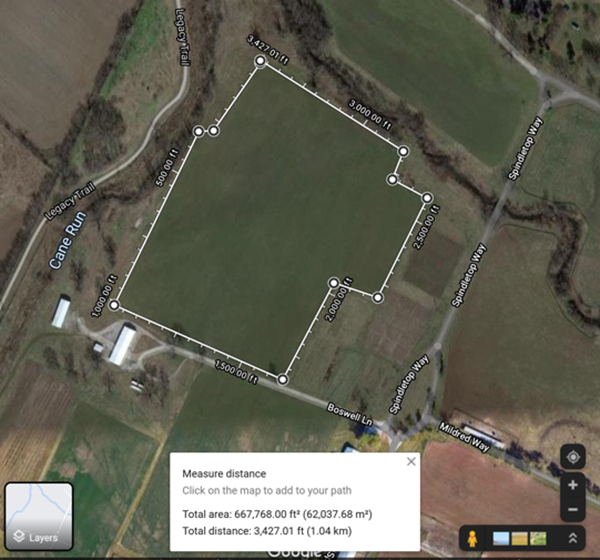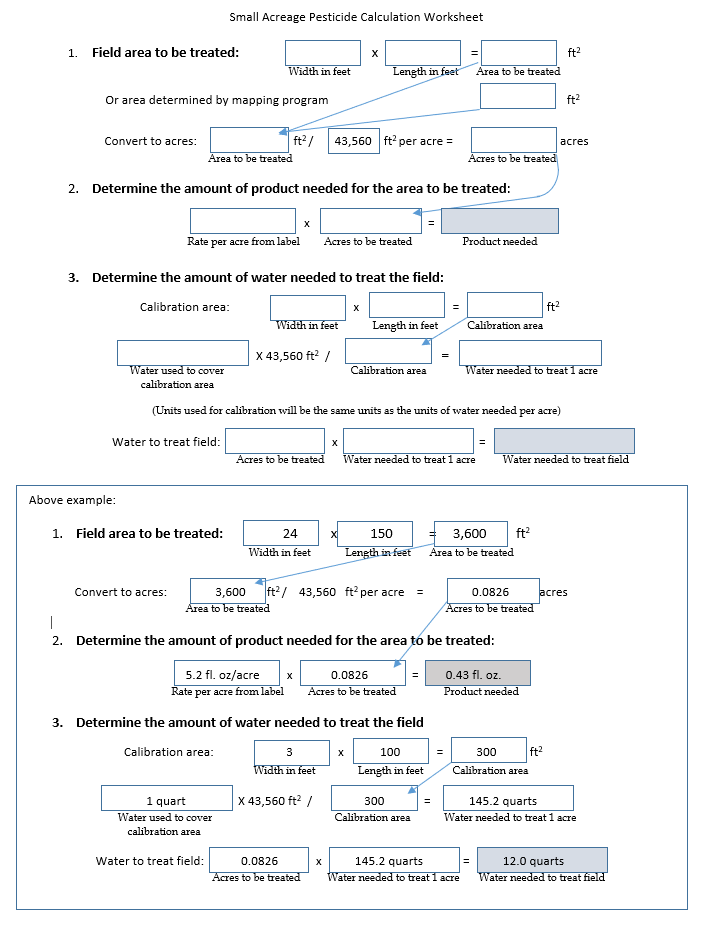Pesticide Calculations for Small Acreages
ENTFACT-800: Pesticide Calculations for Small Acreages | Download PDF
by Ric Bessin, Extension Specialist
University of Kentucky College of Agriculture
Most agricultural pesticide labels list use rates on a per acre basis, but this can pose an issue for many producers of specialty crops. Often only a small fraction of an acre needs to be treated and it is important to apply these pesticides at the correct dose. Over application is illegal as it may result in excessive residues on the harvested produce, injury to the plant, and a waste of money. Under application can result in ineffective control, foster the development of resistance, and also a waste of money. So, determining the correct amount for the proper dosage is required. While there are many different methods to do this, this article outlines a simple process that can be used to determine amounts of products needed for small acreages.

Figure 1. Mapping programs like Google Maps can be used to determine the area if irregular-shaped fields.
1. Determine the area to be treated
The simplest method is to measure the width and length of the area to be treated and multiply those two numbers together. For example, if the area to be treated is 24 feet by 150 feet, then the area would be 3,600 ft2.
(1) 24 ft wide x 150 ft long = 3,600 ft2
There are 43,560 ft2 in an acre, so in this example, the acreage to be treated would be 3,600 divided by 43,560, or 0.0826 acres.
(2) 3,600 ft2 / 43,560 ft2/ acre = 0.0826 acres
While this method works well for rectangular fields, it can be difficult to determine the area of some irregular-shaped fields. On-line mapping programs like Google Maps can calculate the area of irregularly shaped objects. Bring up the field with the mapping program and right click on the edge of the area to treated and select ‘measure distance’. Add more points around the perimeter by right clicking on those points until the object is encircled. The area of the object will be provided in square feet. Convert square feet to acres by dividing the number by 43,560 ft2.
2. Determine the amount of product needed for the area to be treated
First decide on the rate per acre based on the label. While this sounds simple and straight forward, just picking the rate listed on the label for the crop to be treated, many labels list a range of rates allowing the use to select a rate within the range. Generally, the low rate is used for small plants and light insect or disease pressure. As the plants get larger or insect and disease pressure increases, higher rates within the range should be selected. However, we cannot apply more than what is listed on the pesticide labelling.
Take the rate per acre you selected in and multiply that by the acreage you calculated in #1. For example, you decide to apply 5.2 fl. oz. per acre (from the pesticide label) and the area to be treated is 0.0826 acres, then the amount of product needed would be 0.43 fl. oz
(3) 5.2 fl. oz. per acre x 0.0826 acres = 0.43 fl. oz.
You would need to put the 0.43 fl. oz. in the correct amount of water and apply it evenly to the area to be treated. But it would be difficult to measure 0.43 fl. oz., so I convert this to milliliters (mls) so I can use a plastic syringe for accuracy. There are 29.6 mls in a fluid ounce, so in our example we would multiply 0.43 by 29.6 to get 12.7 mls.
(4) 0.43 fl. oz. x 29.6 mls/fl. oz. = 12.7 mls
This is the amount of pesticide needed to treat our field and this can be measured easily and accurately with a syringe.
Another way to measure small amounts of fluids is to use teaspoons or tablespoons. A teaspoon is approximately 5 mls and a tablespoon is 15 mls. So, 12.7 mls would be about 2 and a half teaspoons. But keep in mind that these spoons must to be dedicated to only measure pesticides and not used for other purposes.
(5) 12.7 mls / 5 mls per teaspoon = 2.54 teaspoons
3. Determine the amount of water needed
The method I use is to completely fill the sprayer I plan to use with plain water, then spray a known area. The I measure the amount of water needed to refill the sprayer. For example, I measure out an area 3 ft wide by 100 feet in length (300 ft2). I fill my sprayer and apply water to that area is the same way I plan to apply the pesticide (same speed, pressure, nozzles, etc.). Suppose it took a quart of water to refill the sprayer. To determine the water per acre, take the water need and multiply by 43,560 and divided by the area we treated.
(6) 1 quart x 43,560 ft2/acre / 300 ft2 = 145.2 qt/acre
(7) 145.2 qt/acre / 4 quarts per gallon = 36.3 gal/acre
Multiply this by the area to be treated from #1 to determine the amount of water you need to mix with the pesticide. Here we would need 0.0826 acres x 36.3 gallons. The total amount of water needed would be 3 gallons of water.
(8) 0.0826 acres x 36.3 gallons/acre = 3.0 gallons
So, to apply our pesticide in this example, we would put 12.7 mls in 3 gallons of water to treat an area 24 by 150 feet in size. \
Dry Pesticides
We can do the same with dry pesticides, but the conversion from ounces to grams would be 1 ounce equals 28.35 grams. So, let’s say we wanted to apply a pesticide in the same field that calls for 3.5 oz. per acre. We start the same as above by multiplying the rate per acre by the acreage to be treated.
(3 dry) 3.5 oz. per acre x 0.0826 acres = 0.29 oz.
I measure small amounts of pesticides with a small electric scale that accurately measures in grams. Since there are 28.35 grams in an ounce, we would need to apply 8.22 grams.
(4 dry) 0.29 oz. x 28.35 grams/oz = 8.22 grams
We would calculate the amount of water needed as we did above with the liquid pesticide example.

EXAMPLE WORKSHEET (Download PDF version)
